What kinds of Antique Clocks do we repair?
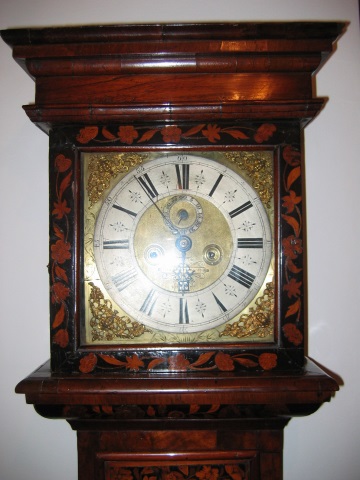 We restore all types of antique clocks including,
We restore all types of antique clocks including,
- Grandfather clocks
- Long case clocks
- Wall clocks
- Mantle clocks
- Clock movement repair and overhaul, wheel cutting
- French movements
- Fusee movements
- Dial and Face painting and overhaul
- Clock case restoration
- Dutch Marquetry restoration
- Bird Cage Movements
Dutch marquetry case and movement restoration of clocks from the William and Mary period are our speciality.
Restoration examples of these clocks can be seen in photographs on our Antique restoration in progress page.
Restoration of Dutch marquetry work can also be seen on our Furniture restoration page.
The English bracket clock.
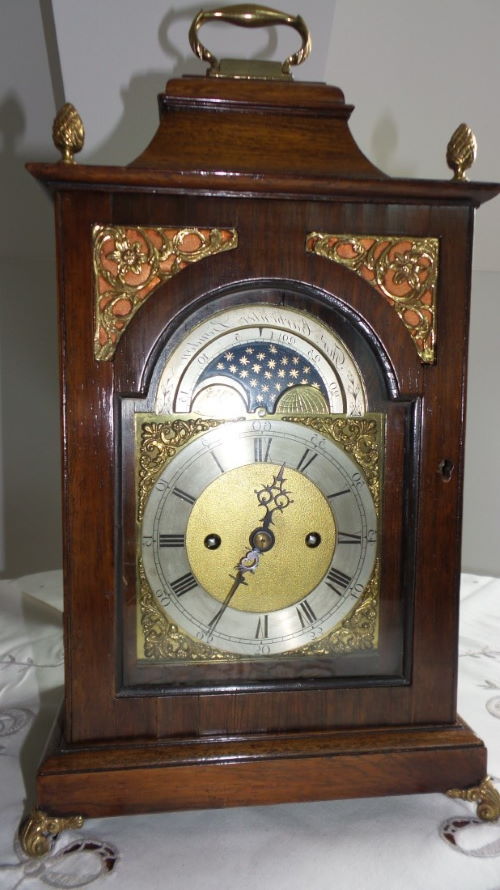
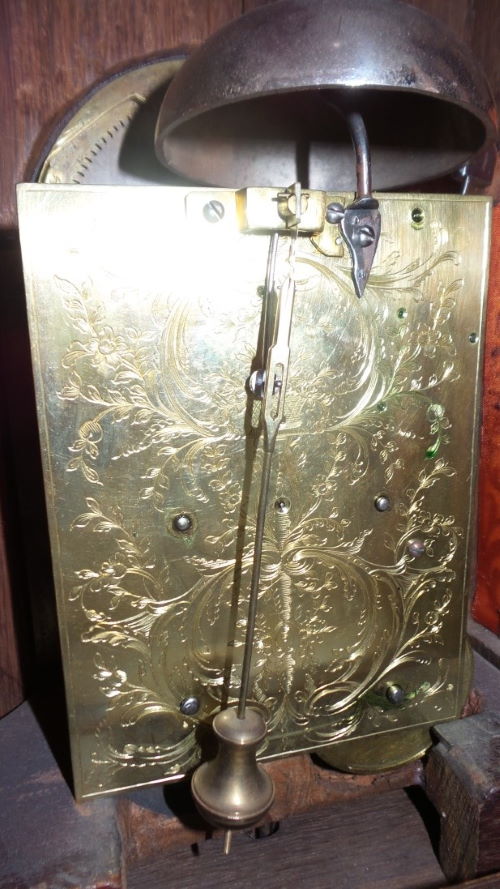
The clock in the photograph is a Very fine and rare antique bracket clock by Thomas Carpenter of London circa 1767
This fine eight-day bracket clock working originally with a verge escapement and at a later date converted to an anchor escapement this clock having a finely engraved back plate striking on a bell with painted lunar phases in a finely made mahogany and gold chased case.
In the second photograph you can see the finely engraved rear with the short pendulum associated with a verge escapement.
The Antique birdcage movement
Birdcage movements are the predecessor of the slightly later longcase clock movement.
These movements differ in various ways. In most examples, the plates holding the movement parts together (such as the wheels and barrels), are on the top and bottom of the movement. This is different to the front and the back placement as seen with traditional longcase clocks. They were not in cases, but instead hung on the wall rather like lantern clock movements.
They had names such as 'wag-on-the-wall' or 'wag-at-the-wall.'
Below, you can see an especially dirty birdcage movement prior to its restoration and after restoration.
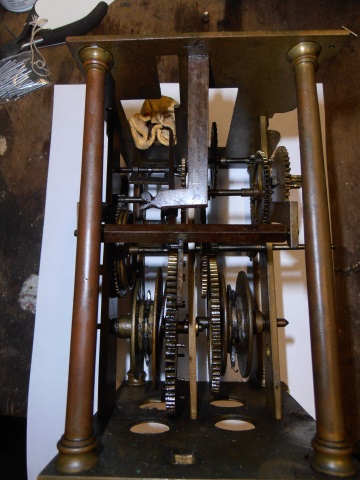
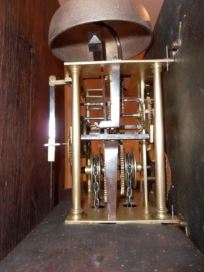
This movement had not been restored for roughly 50 years. After the cleaning process, we discovered that many of the pivots were worn, and the bushing had to be undertaken. On a birdcage movement this can be problematic, as the wheels and shafts run from front to back on small vertical sections of brass. The room for fitting the bush is minimal.
The Antique English Dial Clock
The celebrated timepiece known as the act of Parliament clock, was once only suitable for large rooms, halls and public buildings. Towards the end of the 18th-century, it then became all the more fashionable to produce a slightly smaller clock with a light-coloured dial.
At first these dials were made of brass. Then, they were silvered over and engraved. Later, the painted iron dial was used on contemporary longcase clocks which were covered with a glass front.
After a further stage in their development, these clocks were made smaller and became spring driven. This eliminated the long trunk which once contained the weight, and the entire case was hidden behind the dial. They later became known as the office dial or the dial clock.
These early movements were based on the bracket clocks of the time. They had both verge and fusee escapements. The verge escapement would then go on to be replaced with the anchor escapement.
The cases of these clocks were typically made of a base wood which would have been grained, lacquered or Japanned. In later years, they were mostly made from mahogany or oak.
Please contact us regarding any antique English dial clock restoration you may have and we will be pleased to answer any questions.
The Antique Gallery or Turret clock.
Clocks of this nature were regularly used in large galleries or turrets. They often had a longcase clock style or fusee movements, and were made to be hardy due to their outside movements. These clocks were commonly weight driven.
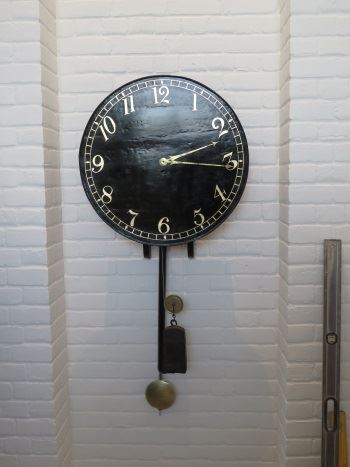
Lantern clock restoration
Up until the end of the Elizabethan era there were scarcely any English clock makers. Nearly all the clocks used in England were made abroad or by foreign European settlers. These workers brought with them the techniques and designs from the countries of which they had once inhabited. Many of these workers were French.
It wasn't until the beginning of the 17th century that the first truly English clock style began to emerge. It was a weight clock, based on the Gothic wall clock found in Europe. The major difference between the two was that a large proportion of brass was included in the movement. The European Gothic clocks of this time were instead made of iron, and their external finish consisted of brass, instead of a sheet of iron decorated with paint.
This type is generally known as the lantern clock. The reason for this name is not certain, though there are many ideas as to why they were called as such. These clocks were shorter than the Gothic wall clocks, and had brass frets that would make the movement accessible for adjustment purposes. They were rope driven, and often had a weight with a slight indent at the top, where lead shot could be added to make the clock run faster or slower.
Around 1657, with the addition of the pendulum to clock work, lantern clocks followed suit, and were also made with pendulums. These early pendulums were short and were used with a verge escapement. After the invention of the anchor escapement, longer pendulums were made, and these early clocks were hung on the wall by a wooden bracket or two metal prongs.
Lantern clocks were originally meant to stand on a bracket on the wall although these clocks have mostly been converted in some way, generally with the escapement being changed. We are more than willing to revert converted escapements to their original crown wheel verge escapements.
We are also able to recast any missing parts including brass side frets, etc.
French clock styles and movements
French movements were fitted into all sorts of cases, from particularly fine French porcelain cases, to black slate clock cases.
There are many styles and designs of French clocks. Some have very attractive gilded sections, with important figures such as Diana (as can be seen in the photographs below), although some are more notably conservative in their design.
This garniture set has been restored by the same process as it was made. The once dim gold is now 24 carat gold, and the verdigris surface has been revived. The movement has had bush and pivot work undertaken and then cleaned.
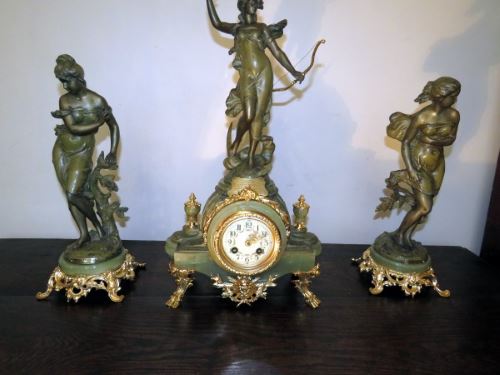
My personal favourites are the Empire period French clocks. These clocks often incorporate ancient Roman and Greek styles and symbolism.
We are able to replace any missing sections of bronze or spelter by using the lost wax principle.
The clock shown below has been restored, and gilded items which were originally missing have been replaced (on this piece it was one of the wings of the butterfly).
The lost wax method was used to replace the missing wing. The remaining wing was used to mould an exact copy.
Below, you can see another French movement prior to and after its restoration. This was found in a garden shed and had aged badly along with dirt and rust. Restoration included comprehensive cleaning and removing rust.
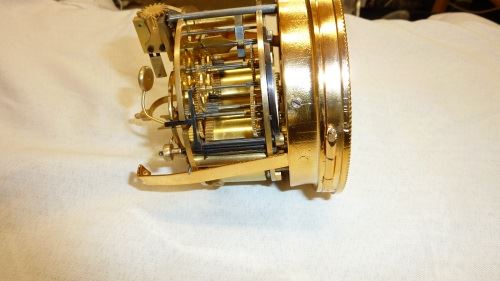
This work involved cleaning each individual part thoroughly, de-rusting all the metal and brass parts, and remaking any parts that were beyond restoration. All parts which have to be remade are an exact copy of the original.
An Irish clock restorer once told me, that when he was young in the 1920s, there were so many worthless back slate clock cases that they were sold for hardcore for the roads!
That of course has now changed, and some of these black clocks are highly sought after with their especially fine French movements.
The English fusee
In this photograph below, you can see a very fine drop dial fusee clock by Charles Frodsham. Unfortunately, this had fallen off of the wall and was completely broken.
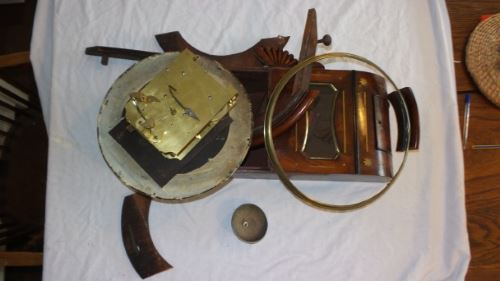
The repair and restoration of the clock included the replacement of the domed glass, and the bezel, which was completely bent (and had to be remade). The movement also had bent shafts, and the brass plates had become badly distorted. Below you can see a picture of the restored clock.
On the right you can see another fine English fusee clock after restoration this particular clock, was in many pieces when it came into the workshop the case had fairly comprehensive restoration, the dial has been repainted and the movement repaired fully to a very high standard
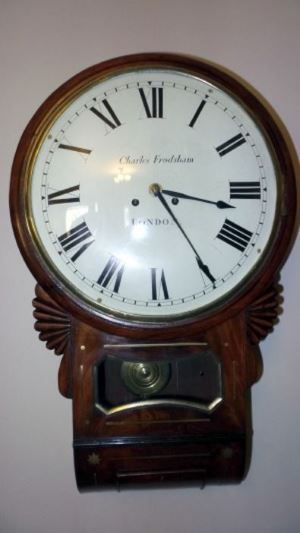
This clock restoration was undertaken in such a way that when the client received it back, he said it looked much better than before the accident!
Please contact us regarding any clock
restoration project you might have. We would be quite pleased to
receive photographs of your damaged clock.
Looking for an experienced antique clock restorer -Green & Cockburn on …
Tel : 01462 790646 or E-mail :enquiries@greenrestoration.co.uk

